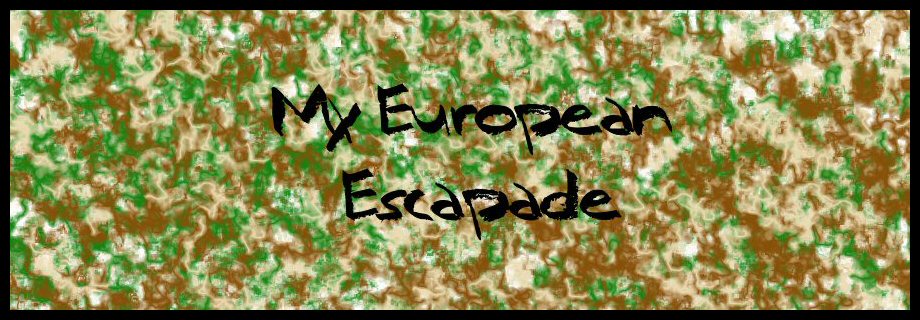Arriving so late in Turkey made it a bit of a problem trying to get to the hostel. We knew we had to buy tickets to Izmir immediately, so we headed straight to the bus station from the airport on the subway. When we got to the depot, I had written down all the names of the companies of busses that Aysegul takes to Izmir and it was easy to find their ticket offices lined up along the front of the bus station. We priced out two and found that they were the same, so we just decided to buy them and take a cab to the hostel. Luckily, before we had left, I had printed out directions to the hostel, written them down in Turkish and everything to prepare us for when we arrived. In Turkey, the cab to the hostel was supposed to be around 35TL (Turkish Lira) which is about $22. We took a cab, which ended up taking us on a spin around the winding and disconnected streets of Istanbul. If Istanbul is known for anything besides being the capital of three ancient empires (Byzantine, Roman and Ottoman Empires) it's known for bad traffic. At 11 PM it wasn't the traffic, but our nicely hidden hostel that prevented the driver from finding the place. I showed him the Turkish directions, which got us to the general area, where he then had to ask regular people where our hostel was. Some knew where it was, some just pointed in a direction, and others had no idea what he was looking for. Eventually, we parked in a lot, and he walked us to the hostel, which was located down a small sidestreet's sidestreet. We checked in, showered (because it was still somewhere in the low 80s) and headed to bed. No sheets needed here, it was so hot. We laughed because we were sharing a room with 8 other people, and it was so hot that everyone was sleeping in their underwear, despite the lack of privacy. I didn't blame them.
The next morning we woke up early and begin our trip around Istanbul. I had talked to the guy at the front desk the last night to find out what to do today, and he had told me the Palace was closed today and so we would have to see that on Saturday when we came back. We headed down to the tram to head to Old City, where we began the day at the magnificent Blue Mosque. Also called the Sultan Ahmet Mosque, the Blue Mosque was completed in 1616 in the Late Classical Ottoman style. It is called the Blue Mosque for the blue tiles on the inside of the mosque and it was built by Sultan Ahmed I to placate Allah in a time of war and violence. It was built immediately next to the Hagia Sophia (the most venerated mosque in Istanbul) and the hippodrome. It is one of the most impressive mosques in the world and its interior is amazing. It is still an active place of worship, and being a mosque, we all had to remove our shoes and everyone had to cover up in respect.
After the Blue Mosque, we crossed the street to see the Hagia Sophia. It wasn't even noon and the sun was already scorching the earth. We had to buy waters (the big ones) and wait in line to enter the Hagia Sophia. I was most excited to see the Hagia Sophia, it is probably one of the most famous places of worship in the world, know throughout time and can even be considered a Wonder of the World (depending who you talk to). The edifice of the building was clearly old, with exposed brick, red and crumbly, and its importance as a monument of Istanbul was more than apparent by its massive size and towering minarets. Built in 537 AD, the Hagia Sophia was originally an Eastern Orthodox Church, the Romans converted it to a Roman Catholic Cathedral and the Turks converted it to an Imperial Mosque. From its date of dedication in 360 AD until 1453 it was the cathedral of Constantinople. It became a mosque in 1453. As a church it was dedicated to the Logos, or the second person of the Holy Trinity.
The greatest thing about the Hagia Sophia, is not its colorful history as a place of worship for two major religions, but really its massive size and scale. This monument was built nearly 1,500 years ago. One thousand years ago, life was so utterly different it is almost unimaginable. The massive dome, is considered to be the epitome of Byzantine architecture, and it changed the history architecture. It was the largest cathedral in the world for nearly 1,000 years, and it contained a large collection of holy relics. It is the location of the excommunication of Michael I Cerularius, which is considered the start of the Great Schism in 1054. In 1453, Sultan Mehmed II, leader of the Ottoman Turks, conquered Constantinople and ordered the Hagia Sophia to become a mosque. The holy relics were removed and the mosaics were plastered over. The minarets and the Islamic features on the interior were added shortly after as the strength of the Ottoman Empire grew. For 500 years, the Hagia Sophia was the principle mosque of Istanbul, and all other mosques were modeled after it not only for the city but for the entire empire.
The inside was awesome. There was marble imported from all over the Roman Empire, from Turkey, Italy, Greece, and Europe. There are columns not only surrounding the first floor but the second as well and the dome towers high above your head. There were hundreds of people in the mosque, but still it felt empty. Although they were renovating one half of the structure, it was still awesome to see the original paintings and frescoes of the Holy Trinity on the wall, painted in gold. There were pictures of the 12 disciples along the walls of the highest ceiling, but were so faded by time you could barely recognize a face. Juxtaposed with the Catholic pictures were beautiful Arabic writings with the many names of Allah written and placed around the ceiling. The altar was replaced by the minbar and other Islamic icons.
When we were ready to leave the mosque, we stopped to get some Turkish food for lunch. I was prepared for this, because I had looked at WikiTravel and wrote down all the things to try when I was in Turkey. We headed to grab some dönör meat and after we got some dondurma, which is Turkish ice cream. It was really good and it's not quite like regular ice cream, it's more stringy and pully in texture, but nonetheless delicious. When we finished eating, we made our way through the twisting and winding streets in an attempt to navigate ourselves to the aqueduct of Valens. These are ancient aqueducts from the Roman Empire. It is also called the Aqueduct to Constantinople, and it was the major water system of Constantinople completed in the late 4th century. Now, it has streets and cars that pass through the arches on the ground, but it was really cool to see. We wandered by Süleymaniye Mosque on the way to the aqueduct, but didn't stop inside because of the heat and we were already "Mosqued" out.
After the aqueduct, it was just too hot to be walking around. We made our way to the tram and headed back across the Golden Horn. The Golden Horn is the water that breaks the European side of Istanbul into two parts. The Golden Horn leads into the Bosphorus Straight, which separates Istanbul onto the European and Asian continents. When we arrived to the other side of the Golden Horn, we made our way to Galta Tower after taking some spectacular pictures of the Old City of Istanbul. It's a picturesque scene, with the afternoon sun shining on the mosques and reflecting off the water. It was beautiful. From the top of Galata Tower, which is one of the oldest towers in the world, we enjoyed spectacular scenes of all Istanbul. From the Beyoglu and New City (with modern skyscrapers) to the Old City mosques and Fatih areas and across the Bosphorus Straight to the Asian side of Istanbul, which is where the Üsküdar area is located. Originally built in 528 as a lighthouse, the Galata Tower was reconstructed by the Romans as Christ Tower.
After the tower, it was time to head to the hostel and take a break. We had done so much for the day. Luckily, on our way back to the hostel, we walked down the famous Istiklal Street, which is a pedestrian walkway that has the best shopping and restaurants of Istanbul. I enjoyed a freshly squeezed juice, with kiwi, banana, apple, orange, pineapple, and some other fruits I'm forgetting. It was great! We showered and rested for a while at the hostel, but we had to eat and get ready to leave for Izmir. Our bus was overnight (8 hours) and so we didn't want to miss this one. We went to a great dinner near our hostel, which was really funny. The waiter thought that Ana and I were a couple, so he placed us on the top floor with all the other couples. The restaurant itself was really nice. Sitting on pillows on the floor, with rich red colors and dark wood paneling, it was quite a romantic setting. The food was delicious and they played Turkish music to set the mood. When we finished, we walked down Istiklal Street in search for some Turkish nargile, or shisha (hookah). We found a nice café, had a mint nargile and played checkers. It was Ana's first time playing checkers in her life, but I taught her well. The waiter however, didn't like that I wasn't letting her win, and on our second game, he made a few moves for me, which let her win. He literally reached over and grabbed my pieces and moved them to a spot I told him I didn't want! He also told Ana where to go too. It was really fun and the weather was nicer now that it had dropped into the 80s. When it was 9:30 PM, we headed to the hostel to grab our luggage and go to the bus station.
We made our way to the station, and boarded our bus after a little confusion (because our bus was late, I had to ask multiple times where it was and people –eager to help—made a big scene and everyone was looking at Ana and I at one point). We were on our way to Izmir to see Aysegul!


